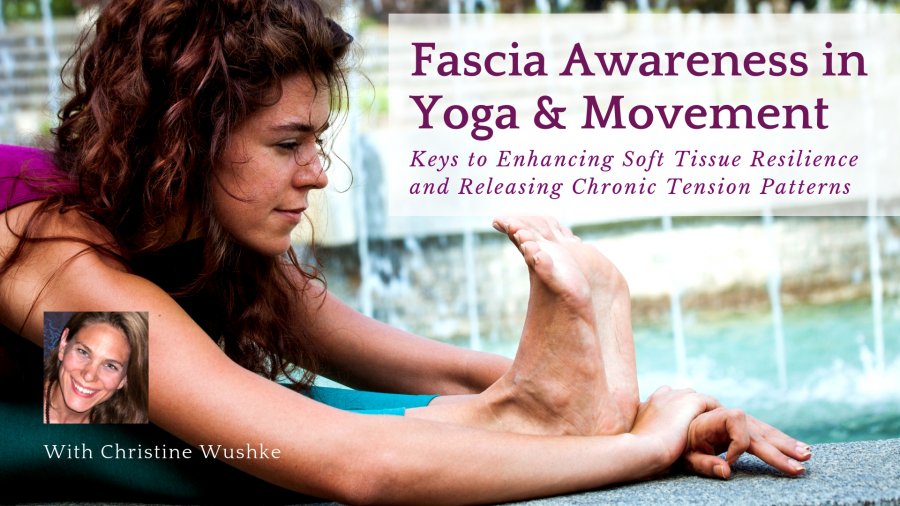Fascia Awareness in Yoga & Movement - Keys to Enhancing Soft Tissue Resilience and Releasing Chronic Tension Patterns
Course Info
- Price:
- $127.00
Christine Wushke
 Christine Wushke has over twenty years of experience helping people find wellness and spiritual transformation. She is a certified yoga therapist and registered as a continuing education provider with Yoga Alliance. To her work with yoga she brings her background as a Certified Hakomi Practitioner...
Christine Wushke has over twenty years of experience helping people find wellness and spiritual transformation. She is a certified yoga therapist and registered as a continuing education provider with Yoga Alliance. To her work with yoga she brings her background as a Certified Hakomi Practitioner... 
Add a new dimension to your yoga practice by integrating fascia awareness and a mindfulness-based approach to movement! If you have ever been curious about the body/mind aspect of yoga and how it can help you or your students, this program is for you.
Study online with myofascial release expert and yoga and Hakomi therapist Christine Wushke to learn how a restricted fascial system can lead to symptoms of pain, and how mindfulness-based solutions can help.
What You Will Learn:
-
Explore ways to release fascia restrictions in a safe and effective manner using gentle yoga and movement-based practices.
-
Understand the nervous system’s role in pain, and how to use neural plasticity to bring about lasting change and overall well-being.
-
Learn how to create new and healthy movement habits to gently strengthen your tissues for more functionality in your everyday tasks.
Mindful Micromovements
Mindfulness-based practices have been shown to create functional movement patterns by reprogramming motor control in the brain. These healthier movement habits aid our tissues in becoming more resilient and pliable which offers us more movement possibilities in our various undertakings. In addition to facilitating healthier movement habits, these mindfulness-based practices improve executive function, neural variability, and decision making.
To put it quite simply: mindfulness-based movements impact both your brain and body to not only make you smarter and stronger, but also help you experience less pain.
Mindful movements are also done in smaller, micro ranges of movement. Moving within tiny ranges is also beneficial for those with chronic pain conditions. Micro-movements that feel pleasurable can motivate and inspire more movement, which can then lead to a gradual improvement of range of motion and strength in a safe and organic way.
We will start these movements small, and gradually increase to an optimal range for each individual.
Creating Tissue Resilience with Mindful Movement
Healthy fascia maintains an even balance of both versatility and mobility. Micromovements are a great way to improve both of these. When it comes to being readily capable of engaging in your day-to-day tasks -- such as loading groceries or going upstairs, the most effective approach is to adopt whole-body solutions that prepare us for these functions. While it can be intimidating to move in certain ways for fear of pain or injury, not moving is actually worse because tissues adapt to whatever loads and forces we put upon our system… including a lack of input. Deliberately practicing mindful whole-body movement is crucial for an improved quality of life.
In this sequence we will look at the principles of biotensegrity and explore how you can integrate them into your yoga practice to facilitate whole-body strength and function. This helps you to get through your day with more ease and safety. We will use functional movement to gently load the tissues appropriately for greater mobility and resilience, which often results in injury prevention as well as a greater tolerance for pain.
Gentle Yoga-Based Myofascial Awareness & Release
Research is telling us that fascia is actually much more sensitive to input than muscles are. And not only is fascia much more sensitive to input, but we’re also learning that pain and threat are highly linked… which means that the type of self-care tools you use matters.
The ability to respond to mild sensation (e.g., light pressure) can be very successful in reducing the sensation of pain, while extraneous tension or bracing (in a fear response for example) can be counter-productive.
Taking time to develop greater awareness of sensations in the fascia and working with myofascial release techniques can offer a chance to reflect inwardly and calm the nervous system while also hydrating tissues to achieve an overall feeling of well-being. In this course, we will look at some of the key ways to use yoga for myofascial release to create a regular selfcare routine to maintain the health of this vital body-wide tissue.
This sequence can be used as a stand-alone sequence for times of higher pain levels, or as a preparation for the following sequences for a more global and long-term solution to more persistent pain conditions.
Embodiment Meditation
A meditation practice that focuses on inner sensing, can have major benefits for pain management and self-care. In this segment of the program we will focus on a mind-body approach to self-care by learning meditation techniques that are body-centered instead of thought-centered. We will journey through sensations in the body, learning reframing techniques to train your awareness to focus on a more pleasing sensation, rather than a painful one.
By the end of this program you will be able to ease your body back into a movement routine that will be less likely to trigger more pain, and more likely to start retraining your awareness and your tissues out of pain and back into pleasure.
This Premium Course also Includes These Bonuses:
-
Yoga practice videos: 3 yoga practices with Christine designed specifically for this course that combines the following:
- Moving through 4 passive poses with props and mindful cuing
- Being guided through about 10 min of body awareness meditation with the balls
-
Recordings of All Webinar Sessions: It’s generally acknowledged that many people only retain 10-20 percent of what they learn in a workshop. You will get access to the recordings of all webinar sessions - both MP3 (downloadable) and MP4 (streaming online), enabling you to go back and listen to the workshop as many times as you like.
-
Transcripts of All Sessions: Ever wanted to refer to a certain part of a course? Even the best note takers miss a point every so often. With the transcripts of the webinar sessions, you can go back and refer to particularly important passages or clarify sections you were in doubt about.